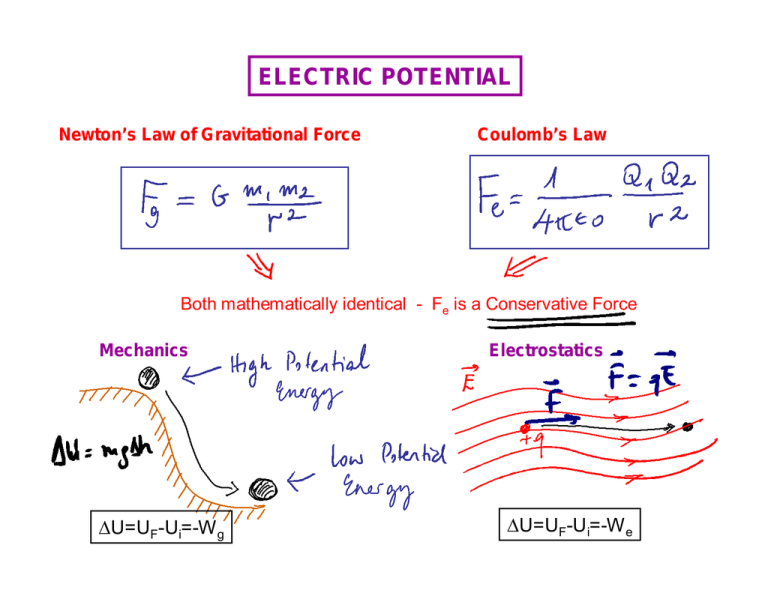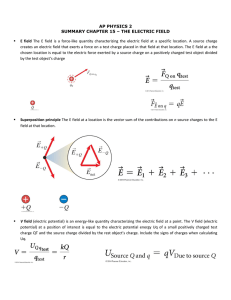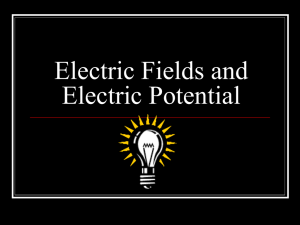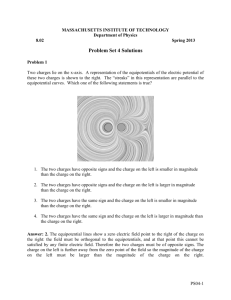electric potential
advertisement

ELECTRIC POTENTIAL Newton’s Law of Gravitational Force Coulomb’s Law Both mathematically identical - Fe is a Conservative Force Mechanics ∆U=UF-Ui=-W g Electrostatics ∆U=UF-Ui=-W e Electric Potential Electric Potential Electric Potential E created around charge Potential Energy per unit charge U V= qo Potential Energy V created around charge Electric Potential Difference - DV ∆V=Vf - Vi ∆U ∆V = q Units 1 volt = 1 Joule per coulomb 1 eV = 1.60x10-19 J Using Electric Potential ∆U=q∆V Electric Potential Energy Relation Between Electric Potential and Electric Field ∆U=q∆V= -W W=? dW=F.dl dW=qE.dl F=qE b r r r r W = ∫ q E .d l = q ∫ E .d l ∆U − W ∆V = = q q b a also a r r ∆V = Vb − Va = − ∫ E.dl b a For Uniform Electric Field r r ∆V = Vb − Va = − ∫ E.dl b a Charged Conducting Sphere Determine the potential at a distance r from the center of a uniformly charged conducting sphere of a radius ro for a) r>ro b) r=ro c) r<ro . The total charge of the sphere is Q. r r ∆V = − ∫ E.dl b a Electric Field Electric Potential Electric Potential due to a Point Charge r r ∆V = − ∫ E.dl b a Electric Potential due to a Point Charge 1 Q V= 4pe o r Potential Due to a Group of Point Charges Superposition Principle VP=V1+V2+….+V6 Potential at point P? 1 Q1 1 Q2 1 Q6 VP = + + ...... + 4pe O r1 4pe O r2 4pe O r6 For N charges N 1 V = ∑ Vi = 4pe o i =1 N Qi ∑ i =1 ri Potential due to a Continuous Charge Distribution 1 dq dV = 4pe o r Consider charge distribution is composed of tiny differential elements of charges dq 1 V= 4pe o V = ∫ dV dq ∫r 1D-Object 2D-Object dq = l dl dq = s dA Q l = L Q s = A 3D-Object dq = r dv Q r = V Potential due to a charged ring 1 dq V= 4pe o ∫ r dq = l dl Q Q l = = L 2pR Potential due to a charged disk 1 dq V= ∫ 4pe o r dq = s dA Q Q s = = 2 A pR EQUIPOTENTIAL SURFACES • Points with the same electric potential form “equipotential surfaces”. • An equipotential surface must be perpendicular to the electric field at any point. Electric Field From Electric Potential r r ∆V = Vb − Va = − ∫ E.dl b Potential if we knew the electric field a r r dV = − E.dl = − El dl dV El = − dl ∂V ∂V ∂V Ex = − , Ey = − , Ez = − ∂x ∂y ∂z • The component of E-field in any direction is equal to the negative of the rate of change of electric potential in that direction. Electric Potential Energy of a System of Point Charges Q: What is the electric potential energy of this system of fixed point charges? The electric potential energy of a system of fixed point charges is equal to the work done to assemble the system bringing the each charge from an infinite distance What is the potential energy U of the system? For N Particles N W = U = ∑ U ij = U12 + U13 + ... i< j




